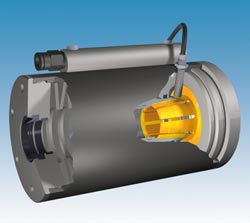ROBA®-linearstop – A safety brake for dynamic linear-motion braking actions

Safety brakes of the ROBA®-linearstop series are designed for dynamic braking applications and can be mounted directly onto standard cylinders according to DIN ISO 15552.<br>
The dynamic safety brakes in the ROBA®-linearstop series work according to the fail-safe principle. The braking force is provided by pressure springs and transferred backlash-free via a conical surface onto a collet. This collet clamps the brake rod continuously, without changing its position. In closed position, the brake is able to withstand loads in both directions of motion. Dynamic braking actions can be achieved from speeds with a maximum of 2 m/s.
Dynamic stops were tested according to the Trade Association testing requirements on the mayr®-Drop Test Stand. In compliance with the Trade Association requirements, the tested elements are switched a million times statically and load-free, and a million times with load assumption. At every thousandth switching, they are braked dynamically from motion. The ROBA®-linearstop brake unit achieved 30,000 dynamic brake applications in fatigue tests with a maximum load and is therefore substantially better than the Trade Association testing requirement, which only stipulates 1,000 dynamic brake applications.
ROBA®-linearstop safety brakes can be mounted directly onto standard cylinders according to DIN ISO 15552. They can also be integrated simply, quickly and without complicated adjustment into different drive constellations. In contrast to other linear braking systems, the ROBA®-linearstop does not have to travel on the carriage. Supplying the pneumatic lines is therefore simplified. The brake can be screwed to a static machine component. The cylindrical piston rod is guided through the central bore of the brake and connected to the carriage of the linear drive.
As the carriage moves, this piston rod pushes itself axially through the ROBA®-linearstop. When the brake closes, the carriage is braked dynamically and then held backlash-free and accurately positioned. The axis is secured in both directions of motion. The brake is released pneumatically at 4 to 6 bar, according to the configured braking force. An integrated sensor continuously reports the switching status of the brake. The ROBA®-linearstop brake unit is supplied in four construction sizes with nominal retention forces of
1.5 kN up to 40 kN.
Chr. Mayr GmbH + Co.KG
Eichenstraße 1, 87665 Mauerstetten
Tel. 08341/804-0, Fax 08341/804-421
E-Mail: info@mayr.de
Media Contact
More Information:
http://www.mayr.comAll latest news from the category: Machine Engineering
Machine engineering is one of Germany’s key industries. The importance of this segment has led to the creation of new university degree programs in fields such as production and logistics, process engineering, vehicle/automotive engineering, production engineering and aerospace engineering among others.
innovations-report offers informative reports and articles covering technologies such as automation, motion, power train, energy, conveyor, plastics, lightweight construction, logistics/warehousing, measurement systems, machine tools and control engineering.
Newest articles

Innovative 3D printed scaffolds offer new hope for bone healing
Researchers at the Institute for Bioengineering of Catalonia have developed novel 3D printed PLA-CaP scaffolds that promote blood vessel formation, ensuring better healing and regeneration of bone tissue. Bone is…

The surprising role of gut infection in Alzheimer’s disease
ASU- and Banner Alzheimer’s Institute-led study implicates link between a common virus and the disease, which travels from the gut to the brain and may be a target for antiviral…

Molecular gardening: New enzymes discovered for protein modification pruning
How deubiquitinases USP53 and USP54 cleave long polyubiquitin chains and how the former is linked to liver disease in children. Deubiquitinases (DUBs) are enzymes used by cells to trim protein…



